|
 Secure Site
Secure Site
|
 |
Archive for the 'Bamboo Chime Clocks' Category
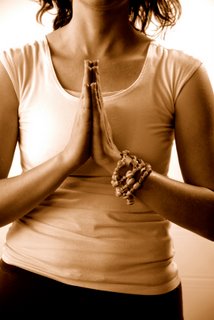 giving thanks Cultivating gratitude can boost well-being—and may help you sleep better.
Gratitude is a fundamental component of most spiritual paths, and a growing body of research suggests that it has important health implications, too, including better sleep, fewer physical ailments, and a greater ability to cope with stressful situations.
“Gratitude elevates, it energizes, it inspires, it transforms,” says Robert Emmons, a University of California, Davis, psychology professor who has helped champion the study of gratitude as a factor in mental and physical health.
A series of studies he conducted in 2003 found that people who kept weekly written records of gratitude slept longer, exercised more frequently, had fewer health complaints, and generally felt better about their lives when compared with those who were asked to record only their complaints. In another study, he found that students who wrote in gratitude journals felt more satisfied with their lives and their school experience.
Practicing conscious gratitude has also been linked with positive mental health. Todd Kashdan, associate professor of psychology at Virginia’s George Mason University, found that when veterans with posttraumatic stress disorder kept gratitude journals, they experienced a greater sense of overall well-being in their lives. “There are two parts of being grateful,” Kashdan says. “One is recognizing that someone benefited in some way, then mindfully seeing the connection to yourself. You have to really be in the present to see what’s happening in your life, what’s causing things to happen, and how you fit into things bigger than yourself.”
A gratitude practice is a natural companion to yoga, which “offers numerous opportunities to reflect on all there is in one’s life to be grateful for,” says Emmons. To begin consciously cultivating gratitude, try considering what life would be like without a pleasure you now enjoy, or think about who you are grateful for. A daily gratitude journal can help you be more mindful of these things in your life. But your gratitude practice doesn’t have to be scripted: Simply taking time on a regular basis to mentally note your blessings is a big step in the right direction.
adapted from Yoga Journal, by Jill Duman
Posted in Bamboo Chime Clocks, Chime Alarm Clocks, intention, mindfulness practice, Now & Zen Alarm Clocks
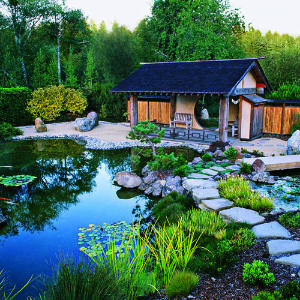 Flecked with water lilies and fringed with greenery, a heart-shaped pond exemplifies the spirit of the Osmosis Meditation Garden. A stone path leads visitors across a small bridge to the Moon Pavilion In the West, gardens are designed for outdoor living as much as for viewing. Japanese gardens, on the other hand, are more for viewing ― to communicate peace and tranquility. The new Meditation Garden at the Osmosis spa in Freestone blends the two approaches. “It’s a Japanese-style garden created for California,” says owner Michael Stusser. The design, by Robert Ketchell, founder of the British Japanese Garden Society, is Japanese, but the use of California native plants and the lovely coastal-hills setting tie it directly to the region.
What makes it so serene? A mirror-smooth pond reflects the day’s changing light and passing clouds. Plantings are simple yet sculptural: a single conifer beside a shapely boulder in one area, a Japanese maple and several conifers in another. Gravel raked in swirls around boulders evokes the feeling of water.
Like Japanese gardens, the Meditation Garden is meant to be viewed through a moon window in the pavilion near the pond. But like a California garden, it invites you in to feel the tranquility.
INFO: Osmosis: The Enzyme Bath Spa (209 Bohemian Hwy., Freestone; 707/823-8231) celebrates its 20th anniversary on Sep 9 with a concert and sushi buffet ($65); tickets limited.
Osmosis is having a 25 year anniversary celebration on September 12th with food music and complementary cedar enzyme foot baths. The cost is $25.
Garden tours are planned for every Sunday in October between 11am and 3:00pm
adapted from Sunset Magazine, by Lauren Bonar Swezey
Posted in Bamboo Chime Clocks, Hot Springs, Now & Zen Alarm Clocks, teahouse, Well-being
 Reiki Treatment Reiki, a Japanese healing treatment, quiets the body and spirit by tapping into a “life force.”
“Universal life energy” is what Reiki (pronounced RAY-kee) means in Japanese. Reiki practitioners use this energy-the subtle vibrational force that surrounds and permeates every living thing- to enhance and balance the body, says Susan Mitchell, a Reiki master and owner of Reiki Healing Arts in Coeur d’Alene, Idaho. “The practitioner acts as a conduit,” explains Beth White, a Reiki master in New York City. “During a session, the energy flows through the practitioner’s hands and you absorb it on a physical, mental, emotional, and spiritual level.” The result? A feeling of meditative peace.
Evidence
Reiki originated in Japan in the 1920s and was brought to the United States in the 1930s by Hawayo Takata, a Japanese-American. Although the studies of Reiki thus far have been small (five larger ones sponsored by the National Institutes of Health are under way), they indicate-as does strong anecdotal evidence-that the method is effective at reducing pain, anxiety, and stress, and increasing a sense of wellbeing. A study published last year in Integrative Cancer Therapies compared the effects of Reiki treatments with the effects of rest on fatigue, pain, anxiety, and overall quality of life in 16 cancer patients. Researchers found that the individuals who received Reiki experienced increases in quality of life and decreases in fatigue, changes that were not seen with rest alone.
Pamela Miles, a Reiki master in New York City and author of Reiki: A Comprehensive Guide (Tarcher, 2006), says the physiological changes seen following a Reiki session include a healthy decrease in heart rate and blood pressure and an increase in salivary immune hormones. “Reiki can help make your body’s self healing mechanism more effective,” she says. “Universal life energy” is what Reiki (pronounced RAY-kee) means in Japanese. Reiki practitioners use this energy-the subtle vibrational force that surrounds and permeates every living thing- to enhance and balance the body, says Susan Mitchell, a Reiki master and owner of Reiki Healing Arts in Coeur d’Alene, Idaho. “The practitioner acts as a conduit,” explains Beth White, a Reiki master in New York City. “During a session, the energy flows through the practitioner’s hands and you absorb it on a physical, mental, emotional, and spiritual level.” The result? A feeling of meditative peace.
 Reiki Evidence
Reiki originated in Japan in the 1920s and was brought to the United States in the 1930s by Hawayo Takata, a Japanese-American. Although the studies of Reiki thus far have been small (five larger ones sponsored by the National Institutes of Health are under way), they indicate-as does strong anecdotal evidence-that the method is effective at reducing pain, anxiety, and stress, and increasing a sense of wellbeing. A study published last year in Integrative Cancer Therapies compared the effects of Reiki treatments with the effects of rest on fatigue, pain, anxiety, and overall quality of life in 16 cancer patients. Researchers found that the individuals who received Reiki experienced increases in quality of life and decreases in fatigue, changes that were not seen with rest alone.
Pamela Miles, a Reiki master in New York City and author of Reiki: A Comprehensive Guide (Tarcher, 2006), says the physiological changes seen following a Reiki session include a healthy decrease in heart rate and blood pressure and an increase in salivary immune hormones. “Reiki can help make your body’s self healing mechanism more effective,” she says.
A typical session
During a Reiki treatment, you lie down on a massage table while the practitioner places her hands in various positions on your head, throat, and front and back torso. (Clients are fully clothed, unless Reiki is used in combination with another treatment like a massage.) You may enter a state of deep relaxation. Many people report seeing colors and moving shapes, sensing pulsations, and feeling hot or cold. In many cases, though, the result is improved energy and a sense of wellbeing. “I go into what feels like a deep sleep,” says Spiegler, “and an hour later I ‘wake up,’ feeling totally rejuvenated.”
adapted from Natural Health Magazine, August 2008 by Susan Hayes
 Bamboo Digital Chime Clock, a Reiki Timer and Clock Now & Zen
1638 Pearl Street
Boulder, CO 80302
(800) 779-6383
Posted in Bamboo Chime Clocks, Chime Alarm Clocks, intention, Japanese Inspired Zen Clocks, mindfulness practice, Now & Zen Alarm Clocks, Well-being
Kyoto meets Giverny in this artful garden, a sublime space for contemplation.
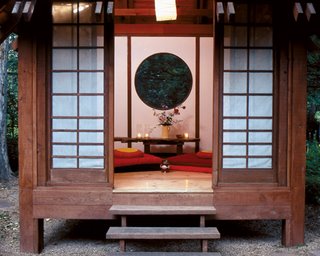 teahouse, photo by Povy Kendal Atchison Japanese shoji screens traditionally are made from translucent rice paper, but the owners chose a durable, light-penetrating fabric that will prevail in harsh weather. It allows filtered light without sacrificing privacy. The floor is salvaged pine planks from a park ranger’s mountain cabin, and a round window brings in the garden even when the doors are closed.
Ten years ago, a Boulder, Colorado, couple bought a house on a patch of grass with some overgrown shrubs, sliced by an irrigation ditch. Where many people might have seen desolation, these intrepid gardeners saw the opportunity to create a private world of solitude and renewal. In the process, they discovered that designing and planting is as soothing as enjoying the completed garden.
The contemplative garden they’ve created gently nods to Asian style while embracing European impressionism. It borrows from 19th-century impressionist painter Claude Monet, as well as from the Japanese love of plant textures, weeping trees and artfully placed rocks. It includes water, rocks, expanses of greenery and winding paths, but not the formal Japanese plantings that require so much upkeep.
Monet’s famous garden in Giverny, France, includes a Japanese bridge over a water lily pond. In this Colorado garden, a pale-aqua bridge arches over an irrigation ditch that’s been funneling water to farmers for 100 years. Just as the lily pad pond became the Monet garden’s major draw, the ditch has been transformed—lined with sandstone rocks alongside a bed of river rocks. Gold, yellow and orange daylilies drape the bank, blooming in midsummer when the Siberian and Japanese irises offer only seed pods. Ornamental grasses bend and sway to the breeze stirred up by the water’s flow. The ditch is an enticement; visitors brace against the railing and peer into the water, watching blossoms float downstream.
Every corner of this garden was designed with careful thought, not lavish funds. A decade of hard work and trial-and-error provided an education.
Piecing together elegance
Every corner of this garden was designed with careful thought, not lavish funds. A decade of hard work and trial-and-error provided an education. In hindsight, the homeowners believe their decision to tackle their garden in small pieces rather than taking on the entire half-acre saved them time, money and frustration.
“We didn’t have a grand master plan,” one of the homeowners admits. Instead, he started by clearing dead and dying trees. Then he parceled the property into smaller gardens: a ditch lined with water-loving plants and flagstones circles the edges of the gardens and is sprinkled with elfin thyme and other herbs for groundcover.
To imitate nature’s undulating, uneven landscape, he built mounds, or berms, from garden soil, adding interest to the flat piece of land. Berms also provide quick drainage for plants that might never take hold without humus and gravel. Sun-loving plants such as foxtail lilies and peonies are located on the sunny mounds. Shade-loving hostas line the flagstone walkways under giant locust trees.
“It all came together like a jigsaw puzzle,” the gardener says, with groundcovers of thyme and vinca, creeping veronica, wild strawberries and sweet woodruff. Groundcovers that can become invasive thugs, such as the sweet woodruff, were banished to the riverbank under the house, where it can duke it out with ornamental strawberries for space and light.
What’s in this garden?
• Crabapple trees (Malus spp), highly adaptable to most weather and soil conditions, have exquisite spring blooms. The weeping varieties include Red Jade, Coral Cascade, White Cascade and Louisa. Best to order from your local garden center.
• Species (or wild) tulips (Tulipa spp) have brilliant hues and hardiness. Long before more formal tulips became the backbone of Dutch gardens, miniature species tulips blanketed hillsides in Turkey. Most only can be grown in climates with winter temperatures. Order from trustworthy companies (see “Resources,” below) that propagate their own bulbs and do not harvest from the wild.
• Foxtail lilies (Eremurus spp) have attention-grabbing feathery spikes and day-glow colors. They’re easy to grow, but they do require good drainage to avoid root rot.
• Thyme (Thymus spp) may be slow to start, but once established, it tolerates some foot traffic. Best as filler between stepping stones, aromatic thymes will creep around rocks and steps, choking out weeds.
• Daylilies (Hemerocallis spp) have sweeping, grasslike foliage and arching blooms. Each blossom lasts only one day, but the plant blooms nonstop throughout summer. They require little care aside from division every few years, and only a moderate amount of water.
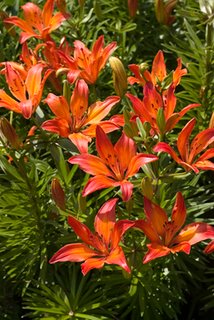 daylilies • Irises (Iris spp) are easy to grow if you choose the right cultivars for your garden. Siberian and Japanese irises grow best in moist, slightly acid soil, perhaps on the banks of a pond or stream. For alkaline soil and aridity, choose bearded irises. And if you love variegated leaves of white and green, look into Iris pallida.
• Hostas (Funkia spp), with wide, variegated leaves, add to foliage interest rather than floral displays. Lords of the shade garden, hostas can be found in a variety of sizes, some with blue-tinged or gold coloration and heart-shape leaves. All need some moisture and dappled shade.
Four seasons of splendor
In this garden, bold plants such as peonies and foxtail lilies are the prima donnas—showy and extravagant with heavy blooms. Other beauties are far smaller and require a closer look. Brilliant red and yellow species tulips—more natural looking than their formal, hybrid cousins—pop up among drifts of thyme. Delphiniums and their smaller brethren, larkspur, join foxgloves for height and extravagant color. Oriental poppies and California poppies display papery petals, popping up in mounds and drifts.
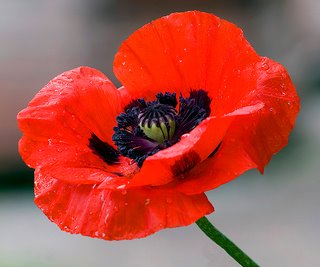 oriental poppy In early spring, the bright blues and purples of the groundcovers cluster throughout the garden, complementing the species tulips’ tiny blooms. By late spring, foxgloves and Siberian and Japanese irises dominate. Summer is golden, as daylilies offer orange, yellow and cream colors.
The garden may be at its best in winter, the gardeners claim. Japanese lanterns guide visitors down the flagstone footpath, and snow sets a black-and-white scene. Bare, weeping crabapple branches bend gracefully like sculpture. “Some of the most beautiful times in the garden are in the snow,” the homeowner says. “You see all the shapes that don’t go away: the mounds, rocks, ornaments, trellises.”
Reflecting in the teahouse
Autumn and winter usher in the garden’s quiet moments, when trowels are put away. A tiny teahouse, built of salvaged cedar siding left over after the house was built, holds sway. Once inside, a cup of hot tea banishes the cold. Sliding shoji screen doors open to the sparkling light on snow or close to keep out a brisk wind. The nine-by-nine-foot teahouse anchors this garden, a reminder that its primary purpose is to promote meditation and reflection rather than busyness. A Zen Timepiece adornes the interior so that one can timer their meditation practice. The naked branches of an old cottonwood tree loom over the teahouse while smaller pines and dwarf evergreens screen the street and neighborhood. “The teahouse gave us a focus for the garden,” the homeowner says, “and cut down the amount of lawn.”
In winter’s stillness, when birds are silent, only the bamboo wind chimes clink softly. The teahouse’s back wall features a round window that provides the most private views and connects the garden to the teahouse. “I wanted a big round window,” the owner says, “to bring the outside in.”
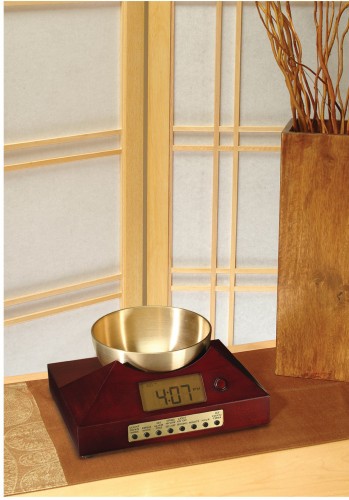 Zen Timepiece with brass singing bowl, a meditation timer. adapted from Natural Home Magazine, March/April 2008 by Niki Hayden
Now & Zen
1638 Pearl Street
Boulder, CO 80302
(800) 779-6383
Posted in Bamboo Chime Clocks, Chime Alarm Clocks, Japanese Inspired Zen Clocks, Now & Zen Alarm Clocks, teahouse, Well-being, Zen Timepiece by Now & Zen, Zen Timers
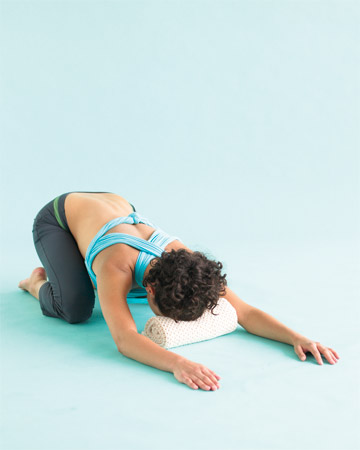 yoga, sooth frazzled nerves pose Friday: Soothe Frazzled Nerves
As another hectic workweek slows to a close, it’s time to downshift — and ramp up your self-care.
Friday’s pose quiets your mind and nervous system, restoring your inner resources so that you can fully enjoy the weekend ahead.
Supported Child’s Pose
What It Does
Releases the muscles in the back, gently opens the hips, boosts your energy.
How to Do It
Set your Zen Timepiece to gong after 5 minutes. Sit back on your heels with your legs folded under you and the tops of your feet on the floor. Open the knees wide and bend forward at the hips.
Rest your forehead (or your chest) on a pillow or blanket and keep your arms slightly bent. If your buttocks don’t reach your heels, place a blanket under your thighs. Relax and breathe deeply for 5 minutes, until your Zen Yoga Timer gongs.
adapted from Body + Soul, 2010
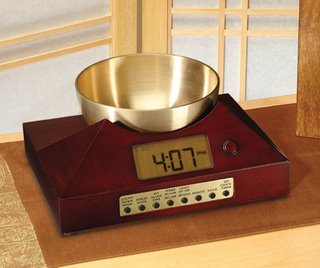 Zen Timepiece with brass singing bowl, a yoga timer
Now & Zen
1638 Pearl Street
Boulder, CO 80302
(800) 779-6383
Posted in Bamboo Chime Clocks, Chime Alarm Clocks, Japanese Inspired Zen Clocks, Meditation Timers, Meditation Tools, Now & Zen Alarm Clocks, Well-being, Yoga Timer, Yoga Timers by Now & Zen, Zen Timepiece by Now & Zen, Zen Timers
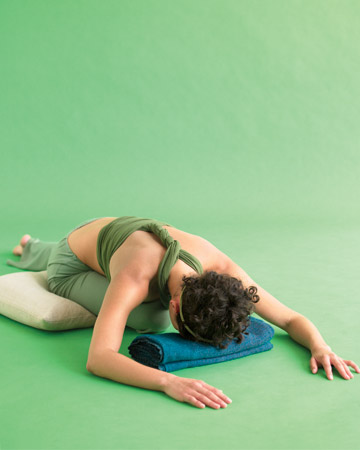 yoga, clear out the gunk pose Clear out the Gunk
What if I don’t get this done in time? Why hasn’t she called? Worries have been accumulating — and they’re cluttering your head. Left unchecked, even the tiniest stressors will inhibit your best ideas from coming through.
Treat yourself to a few moments of stillness with this pose, and watch your inspiration re-emerge.
Supported Pigeon
What It Does
Opens the hips and groin, lets go of stress and pent-up emotions, quiets the mind, and promotes emotional release.
How to Do It
Set your Zen Yoga Timer for 5 minutes so the the chime with end your practice in a calm way. Sitting cross-legged on the floor, swing your left leg around, extending it straight out behind you, tops of the feet and toes against the floor. Fold forward at the hips.
For added support, put a folded blanket or pillow under the right hip. Rest your forehead on a cushion or blanket and relax into the pose 5 minutes until your Zen Timer end with a chime. Repeat with the other leg.
adapted from Body + Soul Magazine, 2010
 Digital Zen Yoga Timer in Walnut Finish Use our unique “Zen Clock” which functions as a Yoga Timer. It features a long-resonating acoustic chime that brings your meditation or yoga session to a gradual close, preserving the environment of stillness while also acting as an effective time signal. Our Yoga Timer & Clock can be programmed to chime at the end of the meditation or yoga session or periodically throughout the session as a kind of sonic yantra. The beauty and functionality of the Zen Clock/Timer makes it a meditation tool that can actually help you “make time” for meditation in your life. Bring yourself back to balance.
Now & Zen – The Yoga Timer Store
1638 Pearl Street
Boulder, CO 80302
(800) 779-6383
 The Zen Yoga Timer and Alarm Clock Store
Posted in Bamboo Chime Clocks, Now & Zen Alarm Clocks, Yoga Timer, Yoga Timers by Now & Zen
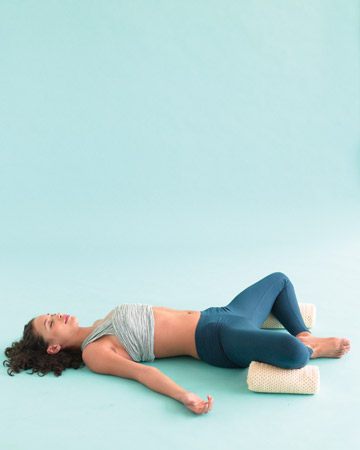 yoga get grounded pose Wednesday: Get Grounded
If a midweek slump has left you out of steam, get back on track by carving out a moment of calm. This easy reclining pose does just that, with an ultra-relaxing stretch that helps you get out of your head.
Supported Goddess
What It Does
Releases tight hips, stretching the groin muscles; connects you to the grounding energy of the root chakra, located at the base of your spine.
How to Do It
Set your Zen Yoga Timer for 5 minutes so that the chime will end your practice peacefully. Lie on your back with the bottoms of your feet touching and knees splayed to the sides, resting on pillows or rolled blankets. Feel your spine on the floor.
Place your palms on your belly or rest your arms out to the sides, palms up. Let your belly slowly rise and fall with each breath. Remain here for 5 minutes, or however long you like.
adapted from Body + Soul, 2010
 Digital Zen Yoga Timers Now & Zen
1638 Pearl Street
Boulder, CO 80302
(800) 779-6383
Posted in Bamboo Chime Clocks, mindfulness practice, Well-being, Yoga Timer, Yoga Timers by Now & Zen
 yoga think clearly pose Tuesday: Think Clearly
You can feel the stress mounting. Remember to take things slowly and stay loose as you find your rhythm. Use this gentle stretch to help undo back and leg tension and keep you grounded and steady.
Supported Seated Forward Bend
What It Does
Stretches hamstrings and inner thighs, releases tension along the spine. Quiets the mind and promotes focus, stimulates the sixth chakra, which activates intuition and wisdom.
How to Do It
Set your Zen Yoga Timer for 5 minutes so that the calm chime will end your practice. Sit on a cushion on the floor with your legs extended on either side of a chair. Fold forward at the hips and rest your forehead and arms on the seat of the chair. Take deep, slow breaths through your nose and hold for 5 minutes.
adapted from Body + Soul, 2010
 Bamboo Digital Chime Clock, a calming timer and alarm clock made from natural materials like bamboo, walnut, and maple Now & Zen
1638 Pearl Street
Boulder, CO 80302
(800) 779-6383
Posted in Bamboo Chime Clocks, intention, Now & Zen Alarm Clocks, Yoga Timer, Yoga Timers by Now & Zen
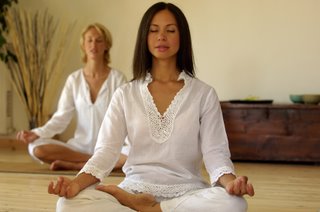 set a yoga timer for 5 or 10 minutes each day Monday is a mind-swirling blur. Tuesday sees a spike in stress levels, and Wednesday requires a Herculean effort just to get out the door. With a schedule as packed as yours, how can you create some bona fide breathing room?
The answer lies in slow, restorative yoga poses that you can do in just 5 to 10 minutes a day. Be sure to set your Zen Yoga Timer by Now & Zen to chime to end this quick yoga pose. “When you stay in a pose without exerting muscular effort, the fascia and ligaments, or connective tissues of your body, get a rare chance to stretch,” explains Noel Schroeder, a Boston-area yoga teacher and co-creator of the DVD “Notice Your Experience.” Stretching these supportive tissues also opens pathways of vital energy (known as “nadis” in the yogic tradition, or meridians in Chinese medicine) that run throughout the body.
Schroeder designed the following pose-a-day yoga plan as a powerful antidote to life’s daily stressors. Use it to ease into your day or to undo tension in the evening — or both.
adapted from Body + Soul Magzine, 2010
Use our unique “Zen Clock” which functions as a Yoga & Meditation Timer. It features a long-resonating acoustic chime that brings your meditation or yoga session to a gradual close, preserving the environment of stillness while also acting as an effective time signal. Our Yoga Timer & Clock can be programmed to chime at the end of the meditation or yoga session or periodically throughout the session as a kind of sonic yantra. The beauty and functionality of the Zen Clock/Timer makes it a meditation tool that can actually help you “make time” for meditation in your life. Bring yourself back to balance.
 Black Lacquer Zen Alarm Clock and Yoga Timer Now & Zen – Yoga Timer and Meditation Clock Store
1638 Pearl Street
Boulder, CO 80302
(800) 779-6383
Posted in Bamboo Chime Clocks, Well-being, Yoga Timer, Yoga Timers by Now & Zen
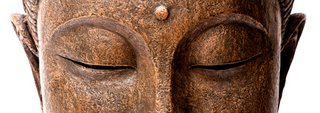 Buddha Maybe your next vacation should be a journey inward.
On the path to the hot springs at Tassajara Zen Mountain Center, I begin a kind of walking meditation, a continual awareness of what I am doing right now. Now I am crossing a footbridge to the baths, now I am taking off my flip-flops, now I am standing in front of an altar and reading the calligraphy: “With all beings/I wash body and mind/free from dust/pure and shining/within and without.”
“Guess my name,” says the little girl who shares the Japanese-style outdoor pool with me.
“Okay. Emma,” I say.
“Do you know her?” her mother asks, puzzled.
“No,” I say, “she just looks like an Emma.”
I’m not clairvoyant, but at retreat centers people converge in unexpected ways. Beyond the pool, past the sun-bleached sycamores on the far side of the creek, seven naked women in sun hats carefully wind their way upstream. There’s something mischievous about them as they wander in haphazard single file. I try to give them a context: Are they workshop participants hunting for wild mushrooms? Who knows? I think of the Zen notion of beginner’s mind, ready for anything, open to everything…and, silently, I thank Emma and the naked women for being here, for opening my mind.
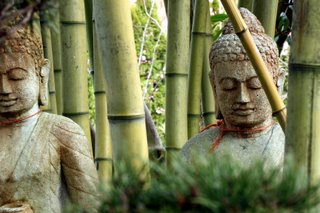 Buddhas In my mid-30s, I became an inveterate retreater. With two small kids, time to myself seemed a thing of the past. So I began to take week-long breaks, alone and seeking contemplation, at cabins, in farmhouses, on islands. Along the way, I discovered one retreat that offered me contemplation as a way of life shared by an entire community. Tassajara is the place I return to year after year.
Slowing way down is the first gift of Tassajara, and slow is the only way to drive the 14-mile dirt road that climbs through the Los Padres National Forest and over a 5,000-foot ridge of the Santa Lucia Mountains to the retreat. I stop and look down the steep descent through firs, sugar pines, tanbark oaks, and madrone into the canyon cut by Tassajara Creek. I exhale deeply, sloughing off my half-day drive south from San Francisco and a few layers of anxiety that have accumulated since my last visit here — the war and its threat to all of us with draft-age children, my divorce driving its way toward finality.
An open gate leads travelers to Tassajara, also known as Zenshin-ji (Zen Mind Temple), founded in 1966 by Japanese Soto Zen priest Shunryu Suzuki Roshi and the San Francisco Zen Center. The first Soto Zen monastery outside of Asia follows a traditional monastic schedule during the fall, winter, and early spring, then opens for guest season from late April through early September.
At Tassajara, where electricity is largely confined to the dining room and kitchen, cell phones don’t work, and a single public telephone is more trouble than it’s worth, guests are offered another way — the way of retreat. Here, the scheme of things is clear. One’s small place in it, uncomplicated.
 Digital Zen Alarm Clocks and Timers, available in maple, walnut, bamboo, and black lacquer Whether here or elsewhere, there are a number of ways to have a retreat. Retreats are times to turn inward, to quiet down, to let your own needs take precedence. At Tassajara, free from cars, buses, jobs, and family responsibilities, you simply bathe, eat, sleep, sit in meditation (or not, as you choose), swim, hike, read. You might venture to the massage kiosk to be kneaded, tapped, stretched, and unblocked. The day’s big excursion could be swimming some laps in the spring-fed creek-side pool, or hiking a mile downstream to a tumble of large boulders and small waterfalls you can ride down to the local swimming hole. Feeling more energetic, you might hike one of the trails — my favorite being up the mountain to the Wind Caves, where you can sit inside shallow, white-sand-floored pockets in the granite cliff face and behold the top of the world. You can return for the organic vegetarian meals, a cuisine pioneered by Tassajara’s Ed Brown and Annie Somerville, the chef of the Zen Center’s San Francisco restaurant, Greens.
Another way of visiting Tassajara is as a workshop participant. “Zen and Yoga” marks a turning point in my retreat life — a threshold to greater community, one that adds structure to my retreat time. With my daughter away at college and my teenage son spending every other week at his dad’s, I no longer crave alone time as I once did. Instead, I’m looking for ways to realign myself in relationship to others. In this context, retreat becomes an active verb.
My workshop takes place in the meditation hall, or zendo, where over the next three days we will examine how sitting meditation and the practice of yoga postures, or asanas, inform and enhance one another. I have brought my Zen Meditation Timer to end my meditation. It’s taught by Victoria Austin, a long-time Zen priest and yoga teacher who is also president of the San Francisco Zen Center. The afternoon we arrive, Victoria introduces us to the statue of a sitting Buddha that dominates the altar in the middle of the hall. When a fire destroyed the old zendo some years ago, the stone statue exploded into hundreds of pieces. Painstakingly reconstructed, the Buddha is almost exactly like the original, but not quite. “This Buddha is like practice itself,” Victoria reminds us. “You’re always putting yourself back together, each time a little differently.” I can relate to that; we all can. Practice reaches far beyond the yoga or meditation mat to include, ultimately, each moment of our waking lives.
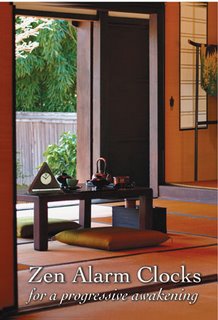 Tea Room with Zen Clock and Timer After restorative yoga, dinner, and an evening plunge in the hot springs, I’m as relaxed as I’ve ever been, in a comfy bed in my roomy turn-of-the-century cabin, lulled to sleep by the sound of water tumbling over creek stones. I’m awakened before dawn by the boom of a mallet striking a wooden block, calling the entire community to meditate in the zendo. An hour of sitting sorely reminds me of all the muscles it takes to sit that long, that straight. After temple cleaning, my workshop group continues with asana practice, all 25 of us spread out over the zendo, assuming Mountain, Tree, and Triangle poses, the Warrior series, and all the standing poses to fully awaken.
Famished, at breakfast I have a hard time choosing between the offerings: polenta with fresh strawberries, kiwis, and bananas, and the pancakes with raspberry compote. I sit at a table in the dining hall overlooking the creek with three women stem-cell researchers from Stanford University, a woman running for county supervisor, and a Minnesota man who founded a successful marketing firm. Busy lives and type-A personalities are a common bond for many people attracted to retreats.
Later that day, I talk to the gregarious guy from Minnesota. “I’m usually shy and standoffish, judgmental,” he admits to me, “but I decided to pay attention yesterday during sharing time.” He pauses to let a little cynical emphasis grin through. “I felt completely drawn to each story; it made me want to engage with everyone here.” I found myself wishing I’d done that. “Funny what’s possible,” he says.
It’s been a day of intense physical work, experimenting with yoga poses that help strengthen our meditation posture and focus our attention. Lying still, during Savasana, our last pose, Victoria says to us, “Let sounds come to you rather than pulling in the sounds.” I drift in and out, aware of the sound of footsteps on the gravel path, of the squawk of the ubiquitous blue jays, but most of all of our sighing — an ongoing chorus vocalizing the deep pleasure of exertion and release, a natural by-product of the primary work we are doing: following our breath in and out.
The next night at Victoria’s dharma talk, she compares the monks’ winter practice at Tassajara to one long breathing in, or refreshing the practice, and the summer guest season to a long breathing out, or giving to the larger community. I resolve to work on that out-breath.
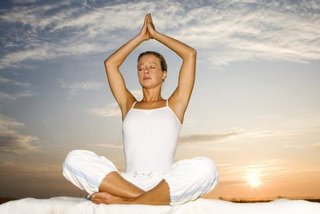 yoga Afterward the low light of kerosene lanterns dimly illuminates the path back to my cabin. I stop to watch the new moon rising above steep black slopes.
It is summer solstice night. Looking deeper, into the bright and scattered stars, I feel as if I’m standing in a roofless cathedral, buttressed by the Santa Lucias, part of some great force tilted upward in praise. My body tingles from the demands of the day, fledgling upper-back muscles awakened, all my cells celebrating in active communion. Attention. I whisper the word to myself, like an ancient secret. I raise my arms to the new moon in thankful salutation, take a long breath in, and sigh it westward, down the path of the year’s longest day.
For reservations call (415) 865-1895 or visit sfzc.org/tassajara/.
Adapted from Body + Soul, April/May 2005
Posted in Bamboo Chime Clocks, Hot Springs, Japanese Inspired Zen Clocks, Meditation Tools, mindfulness practice, Now & Zen Alarm Clocks, Well-being, zen monks
« Previous Page — « Previous Entries
Next Entries » — Next Page »
|
|
|
|